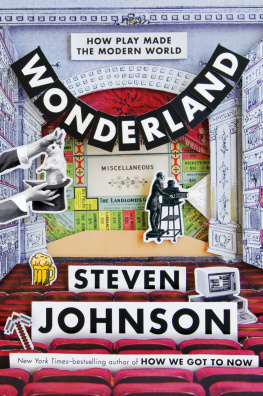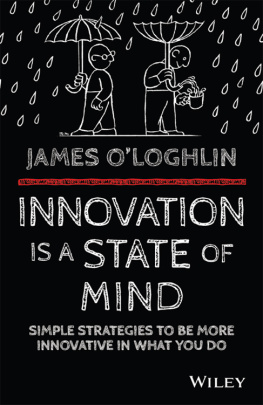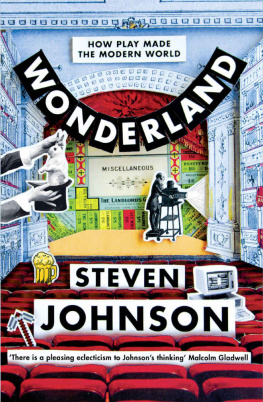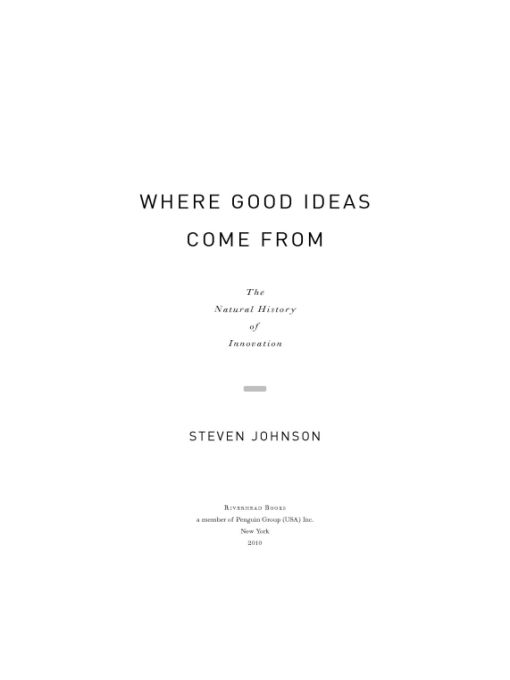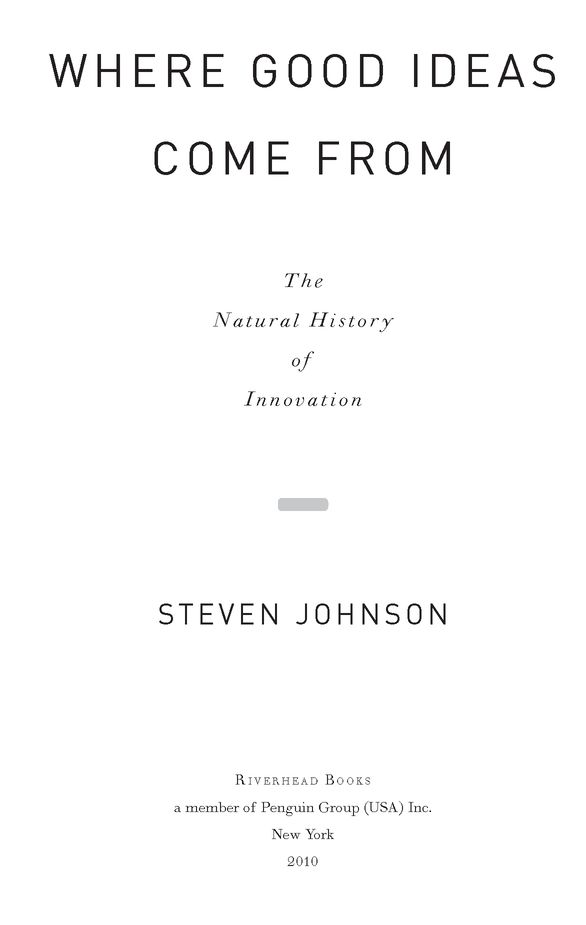Table of Contents
ALSO BY STEVEN JOHNSON
Interface Culture:
How New Technology Transforms the Way We Create and Communicate
Emergence:
The Connected Lives of Ants, Brains, Cities, and Software
Mind Wide Open:
Your Brain and the Neuroscience of Everyday Life
Everything Bad Is Good for You:
How Todays Popular Culture Is Actually Making Us Smarter
The Ghost Map:
The Story of Londons Most Terrifying Epidemicand How
It Changed Science, Cities, and the Modern World
The Invention of Air:
A Story of Science, Faith, Revolution, and the Birth of America
For Peter
Introduction
REEF, CITY, WEB
... as imagination bodies forth
The forms of things unknown, the poets pen
Turns them to shapes and gives to airy nothing
A local habitation and a name.
SHAKESPEARE, A Midsummer Nights Dream, V.i.14-17
Darwins Paradox
April 4, 1836. Over the eastern expanse of the Indian Ocean, the reliable northeast winds of monsoon season have begun to give way to the serene days of summer. On the Keeling Islands, two small atolls composed of twenty-seven coral islands six hundred miles west of Sumatra, the emerald waters are invitingly placid and warm, their hue enhanced by the brilliant white sand of disintegrated coral. On one stretch of shore usually guarded by stronger surf, the water is so calm that Charles Darwin wades out, under the vast blue sky of the tropics, to the edge of the live coral reef that rings the island.
For hours he stands and paddles among the crowded pageantry of the reef. Twenty-seven years old, seven thousand miles from London, Darwin is on the precipice, standing on an underwater peak ascending over an unfathomable sea. He is on the edge of an idea about the forces that built that peak, an idea that will prove to be the first great scientific insight of his career. And he has just begun exploring another hunch, still hazy and unformed, that will eventually lead to the intellectual summit of the nineteenth century.
Around him, the crowds of the coral ecosystem dart and shimmer. The sheer variety dazzles: butterflyfish, damselfish, parrotfish, Napoleon fish, angelfish; golden anthias feeding on plankton above the cauliflower blooms of the coral; the spikes and tentacles of sea urchins and anemones. The tableau delights Darwins eye, but already his mind is reaching behind the surface display to a more profound mystery. In his account of the Beagles voyage, published four years later, Darwin would write: It is excusable to grow enthusiastic over the infinite numbers of organic beings with which the sea of the tropics, so prodigal of life, teems; yet I must confess I think those naturalists who have described, in well-known words, the submarine grottoes decked with a thousand beauties, have indulged in rather exuberant language.
What lingers in the back of Darwins mind, in the days and weeks to come, is not the beauty of the submarine grotto but rather the infinite numbers of organic beings. On land, the flora and fauna of the Keeling Islands are paltry at best. Among the plants, there is little but cocoa-nut trees, lichen, and weeds. The list of land animals, he writes, is even poorer than that of the plants: a handful of lizards, almost no true land birds, and those recent immigrants from European ships, rats. The island has no domestic quadruped excepting the pig, Darwin notes with disdain.
Yet just a few feet away from this desolate habitat, in the coral reef waters, an epic diversity, rivaled only by that of the rain forests, thrives. This is a true mystery. Why should the waters at the edge of an atoll support so many different livelihoods? Extract ten thousand cubic feet of water from just about anywhere in the Indian Ocean and do a full inventory on the life you find there: the list would be about as poor as Darwins account of the land animals of the Keelings. You might find a dozen fish if you were lucky. On the reef, you would be guaranteed a thousand. In Darwins own words, stumbling across the ecosystem of a coral reef in the middle of an ocean was like encountering a swarming oasis in the middle of a desert. We now call this phenomenon Darwins Paradox: so many different life forms, occupying such a vast array of ecological niches, inhabiting waters that are otherwise remarkably nutrient-poor. Coral reefs make up about one-tenth of one percent of the earths surface, and yet roughly a quarter of the known species of marine life make their homes there. Darwin doesnt have those statistics available to him, standing in the lagoon in 1836, but he has seen enough of the world over the preceding four years on the Beagle to know there is something peculiar in the crowded waters of the reef.
The next day, Darwin ventures to the windward side of the atoll with the Beagles captain, Vice Admiral James FitzRoy, and there they watch massive waves crash against the corals white barrier. An ordinary European spectator, accustomed to the calmer waters of the English Channel or the Mediterranean, would be naturally drawn to the impressive crest of the surf. (The breakers, Darwin observes, are almost equal in force [to] those during a gale of wind in the temperate regions, and never cease to rage.) But Darwin has his eye on something elsenot the violent surge of water but the force that resists it: the tiny organisms that have built the reef itself.
The ocean throwing its waters over the broad reef appears an invincible, all-powerful enemy; yet we see it resisted, and even conquered, by means which at first seem most weak and inefficient. It is not that the ocean spares the rock of coral; the great fragments scattered over the reef, and heaped on the beach, whence the tall cocoa-nut springs, plainly bespeak the unrelenting power of the waves... Yet these low, insignificant coral-islets stand and are victorious: for here another power, as an antagonist, takes part in the contest. The organic forces separate the atoms of carbonate of lime, one by one, from the foaming breakers, and unite them into a symmetrical structure. Let the hurricane tear up its thousand huge fragments; yet what will that tell against the accumulated labour of myriads of architects at work night and day, month after month?
Darwin is drawn to those minuscule architects because he believes they are the key to solving the mystery that has brought the Beagle to the Keeling Islands. In the Admiraltys memorandum authorizing the ships five-year journey, one of the principal scientific directives is the investigation of atoll formation. Darwins mentor, the brilliant geologist Charles Lyell, had recently proposed that atolls are created by undersea volcanoes that have been driven upward by powerful movements in the earths crust. In Lyells theory, the distinctive circular shape of an atoll emerges as coral colonies construct reefs along the circumference of the volcanic crater. Darwins mind had been profoundly shaped by Lyells understanding of the deep time of geological transformation, but standing on the beach, watching the breakers crash against the coral, he knows that his mentor is wrong about the origin of the atolls. It is not a story of simple geology, he realizes. It is a story about the innovative persistence of life. And as he mulls the thought, there is a hint of something else in his mind, a larger, more encompassing theory that might account for the vast scope of lifes innovations. The forms of things unknown are turning, slowly, into shapes.












